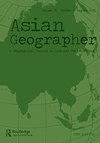参与式绘制社区赋权图
IF 2.2
Q2 GEOGRAPHY
引用次数: 13
摘要
本文试图展示参与式制图实践如何有助于当地水资源管理,从而增强社区的权能。像查普拉这样的河岸社区由于当地水资源开发项目的地理因素而遭到排斥。为了理解这种排斥,本文重点研究了研究问题;为什么恒河-科博达克河和戈莱河修复工程只覆盖了恰普拉的部分地区,而忽略了其他地区?这个问题在这里是通过利用基于定性和定量数据分析的参与式制图与制图知识相协调来解决的。对于这些数据,我使用了我在2011-2012年在孟加拉国查普拉的戈莱河岸社区的博士实地工作经验。我的数据分析发现,项目的边界选择遵循自上而下的方法,包括一些特定的地理区域,并根据特定的利益排除其他区域。为了了解这种方法对恰普拉社区的影响并促进社区参与,本文分为三个主要部分:我的实地调查背景下的参与式测绘,自下而上的测绘方法作为社区包容的基础,以及社区赋权的参与式测绘:地方发展和资源保护。这些章节将有助于回答上述研究问题,并有助于通过参与式绘图方法更好地理解社区赋权。本文章由计算机程序翻译,如有差异,请以英文原文为准。
Participatory mapping for community empowerment
ABSTRACT This paper attempts to show how participatory mapping practices can contribute to local water resource management for community empowerment. The river bank communities such as Chapra encounter exclusion because of geographic aspects of local water development projects. To understand this exclusion, this paper focuses on the research question; why did the Ganges-Kobodak and the Gorai River Restoration Projects cover some parts of Chapra and ignore others? This question is addressed here by using participatory mapping based on qualitative and quantitative data analyses in coordination with cartographic knowledge. For these data, I use my Ph.D. fieldwork experiences in 2011–2012 on the Gorai River bank communities at Chapra in Bangladesh. My data analyses found that the projects’ boundary selection follows the top-down approach that includes some specific geographic areas and excludes others based on specific interests. To understand the effects of this approach on Chapra communities and to promote community participation, this paper is divided into three major sections: participatory mapping in the context of my fieldwork site, bottom-up mapping approach as foundation for community inclusion, and participatory mapping for community empowerment: local development and resource conservation. These sections will be helpful for responding the above research question and for developing better understanding about community empowerment by participatory mapping approach.
求助全文
通过发布文献求助,成功后即可免费获取论文全文。
去求助
来源期刊

Asian Geographer
GEOGRAPHY-
CiteScore
3.30
自引率
0.00%
发文量
7
期刊介绍:
Asian Geographer disseminates knowledge about geographical problems and issues focusing on Asia and the Pacific Rim. Papers dealing with other regions should have a linkage to Asia and the Pacific Rim. Original and timely articles dealing with any field of physical or human geographical inquiries and methodologies will be considered for publication. We welcome, for example, submissions on people-environment interactions, urban and regional development, transport and large infrastructure, migration, natural disasters and their management, environment and energy issues. While the focus of the journal is placed on original research articles, review papers as well as viewpoints and research notes under the category of “Asian Geography in Brief” are also considered. Review papers should critically and constructively analyse the current state of understanding on geographical and planning topics in Asia. The ‘Asian Geography in Brief’ section welcomes submissions of applied geographical and planning research about Asia. The section aims to showcase (1) the diverse geography and planning of Asia; and (2) the diverse geographical and planning research about Asia. The journal will also publish special issues on particular themes or areas. Book reviews can be included from time to time.
 求助内容:
求助内容: 应助结果提醒方式:
应助结果提醒方式:


